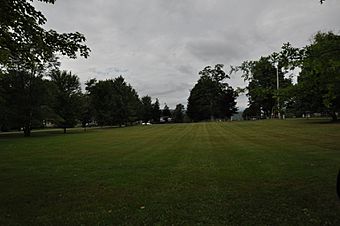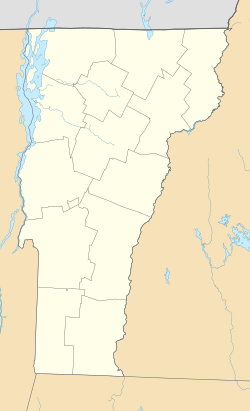Waitsfield Common Historic District facts for kids
Quick facts for kids |
|
|
Waitsfield Common Historic District
|
|
 |
|
| Location | Joslin Hill Rd, North Rd., East Rd., and Common Rd., Waitsfield, Vermont |
|---|---|
| Area | 237 acres (96 ha) |
| Built | 1793 |
| Architectural style | Federal, Greek Revival, et al. |
| NRHP reference No. | 01001227 |
| Added to NRHP | November 8, 2001 |
The Waitsfield Common Historic District is a special area in Waitsfield, Vermont. It was the very first town center for Waitsfield. You can find it where Joslin Hill, Common, East, and North Roads meet. This historic spot is about 1 mile (1.6 km) away from the main village of Waitsfield today. It was first planned out in 1793. The district includes a triangular town common, an old cemetery, and many houses built between 1793 and 1841. This important area was added to the National Register of Historic Places in 2001.
Exploring Waitsfield's First Town Center
This historic district is located around the four-way intersection of Joslin Hill, Common, East, and North Roads. The common itself is made up of two triangular sections, one northeast and one southwest of this meeting point. The old cemetery and where the first church stood are to the northwest. Historic houses line the southern part of the common. You can also see old stone walls along some of the roads.
The History of Waitsfield Common
The Waitsfield Common area was first settled in the 1790s. Its location on a hilltop was common for many early Vermont towns. The town common was originally a rectangle, but it was changed to two triangles in 1798. The cemetery was started by 1797. The town's very first church was built on land that is now part of the cemetery. It was taken down in the 1870s.
Over time, the hilltop location of the common wasn't the best for businesses in the 1800s. By 1841, the current Waitsfield Village became more important than the common area. Since then, Waitsfield Common has mostly stayed a quiet farming village. However, some new buildings were added in the late 1900s. This happened as more tourists and skiers started visiting the area.
What You Can See in the District
The historic district covers about 237 acres (96 hectares). It includes open fields that slope down to the west and south. There are seven historic houses in the district. Many newer houses have also been built, but they are designed to fit in with the older buildings.



